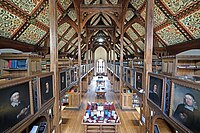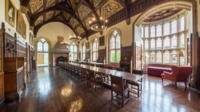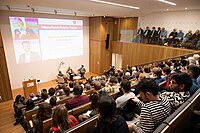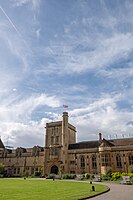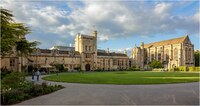Mansfield College, Oxford
| Mansfield College
| |||||||||||||||||||
|
Deus locutus est nobis in filio | |||||||||||||||||||
|---|---|---|---|---|---|---|---|---|---|---|---|---|---|---|---|---|---|---|---|
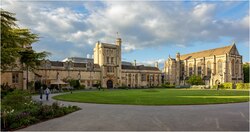
| |||||||||||||||||||
 | |||||||||||||||||||
| Principal: | Helen Mountfield | ||||||||||||||||||
| Website: | www.mansfield.ox.ac.uk | ||||||||||||||||||
| |||||||||||||||||||
| Location | |||||||||||||||||||
| Grid reference: | SP51660679 | ||||||||||||||||||
| Location: | 51°45’27"N, 1°15’10"W | ||||||||||||||||||
Mansfield College, Oxford is one of the constituent colleges of the University of Oxford. The college was founded in Birmingham in 1838 as a college for Nonconformist students. It moved to Oxford in 1886 and was renamed Mansfield College after George Mansfield and his sister Elizabeth. In 1995 a royal charter was awarded giving the institution full college status. The college grounds are located on Mansfield Road, near the centre of Oxford.
As of February 2018, the college comprises 231 undergraduates, 158 graduates, 34 visiting students, and 67[1] fellows and academics.
History
The college was founded in 1838, under the patronage of George Storer Mansfield (1764–1837) and his two sisters Sarah (1767–1853) and Elizabeth (1772–1847), as Spring Hill College, Birmingham, a college for Nonconformist students.[2][3] In the nineteenth century, although students from all religious denominations were legally entitled to attend universities, they were forbidden by statute from taking degrees unless they conformed to the Church of England.
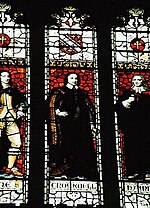
In 1871, the Universities Tests Act abolished all religious tests for non-theological degrees at Oxford, Cambridge and Durham Universities.[4] For the first time the educational and social opportunities offered by Britain's premier institutions were open to some Nonconformists. The Prime Minister who enacted these reforms, William Ewart Gladstone, encouraged the creation of a Nonconformist college at Oxford.
Spring Hill College moved to Oxford in 1886[5] and was renamed Mansfield College after George Mansfield and his sister Elizabeth. The Victorian buildings, designed by Basil Champneys on a site bought from Merton College, were formally opened in October 1889.[6]
Mansfield was the first Nonconformist college to open in Oxford. Initially the college accepted men only, the first woman (Constance Coltman) being admitted to read for an external degree in 1913.
During Second World War, over forty members of staff from the Government Code and Cypher School moved to the college to work on British codes and cyphers.[7]
Like many of Oxford's colleges, Mansfield admitted its first mixed-sex cohort in 1979, having previously not accepted women to read for Oxford degrees.[8]
In 1955 the college was granted the status of permanent private hall within the University of Oxford and in 1995 a royal charter was awarded giving the institution full college status.
Nonconformist roots
Since the college was first formally integrated into the university structure in 1955, its Nonconformist aspects have gradually diminished. Until 2007 Mansfield trained United Reformed Church ordinands, who became fully matriculated members of the university and received degrees.[9]
The Nonconformist history of the college is however still apparent in a few of its features. A portrait of Oliver Cromwell hangs in the Senior Common Room and portraits of the dissenters of 1662 hang in the library and the corridors of the main college building, together with portraits of William Fiennes, 1st Viscount Saye and Sele, John Hampden, Thomas Jollie and Hugh Peters.
The college chapel is unconsecrated, and contains stained glass windows and statues depicting leading figures from Nonconformist movements, including Cromwell, Sir Henry Vane and William Penn.[6] Chapel services are still conducted in a Nonconformist tradition. Over the years attendance at chapel services has declined and the make-up of the general student body no longer reflects the Nonconformist religious origins of the college.
Grounds
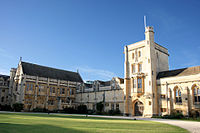
The grounds of Mansfield College are located on Mansfield Road, near the centre of Oxford, and to the south of the Science Area. The grounds are near the University Parks and the River Cherwell. The college shares a boundary wall with Wadham College.
Buildings
The main building was designed by architect Basil Champneys, and built between 1887 and 1889. It houses the main college library, the law library and the theology library. It is also home to the college's Junior Common Room, Middle Common Room, and Senior Common Room. The main college building encloses three sides of the large quadrangle,[6] which has a circular lawn. The college also has several other buildings, primarily used for student accommodation, which are opposite the main building.
Unusually, Mansfield College is not accessed through the porter's lodge, the college staff maintaining that this is representative of its open and non-conformist ethos. However, early outlines of schematics for the college show an enclosed second quadrangle behind the main building, with the front tower serving as a gatehouse into this area. However, the college's constituent poverty and lack of funds owing to its non-conformist history prevented these plans from being executed. What was planned to be a traditional style porter's lodge can still be found in the main building: on 1902 plans, the tiny room opening directly on to the entrance hall is labelled 'Porter'.[10]
Pictures
| ("Wikimedia Commons" has material about Mansfield College, Oxford) |
-
Library, Interior
-
Old Hall, Interior
-
John Marsh Building
-
Mansfield College Public Talk
-
Tower Building
-
Mansfield-Ruddock Art Exhibition
-
Aerial view of Mansfield College Quad (L-R: Principal’s Lodgings, JCR; Library, Tower Building, Old Hall, Chapel)
-
Mansfield College Quad
-
Spring Hill College, 1870
-
Spring Hill College, present day
Outside links
References
- ↑ "Mansfield People". Mansfield College, Oxford. https://www.mansfield.ox.ac.uk/mansfield-people.
- ↑ "Mansfield College Historical Background". http://www.mansfield.ox.ac.uk/about/historical-background.html?type=0.
- ↑ Mansfield College, Oxford: Its Origin and Opening, October 14-16, 1889. Oxford. 1890. pp. 3–4. OCLC 794856901. https://books.google.com/books?id=VVMBAAAAYAAJ.
- ↑ "Universities Tests Act 1871 s.3". http://www.opsi.gov.uk/RevisedStatutes/Acts/ukpga/1871/cukpga_18710026_en_1.
- ↑ Mansfield College, pp. 25–26, 38–41.
- ↑ 6.0 6.1 6.2 Mansfield College, pp. 45–49.
- ↑ "Our Story". Bletchley Park. http://www.bletchleypark.org.uk/content/hist/wartime/diaries/august1939.rhtm.
- ↑ Communication from Nicola Patrick, college librarian
- ↑ "The last URC minister to qualify through Mansfield College". http://www.urc.org.uk/news/2009/june/mansfield_college.
- ↑ Mansfield: Portrait of An Oxford College. London: Third Millennium. 2012. pp. 61, 65. ISBN 9781906507497.
| Colleges of the University of Oxford | |
|---|---|
| Colleges:
All Souls • Balliol • Brasenose • Christ Church • Corpus Christi • Exeter • Green Templeton • Harris Manchester • Hertford • Jesus • Keble • Kellogg • Lady Margaret Hall • Linacre • Lincoln • Magdalen • Mansfield • Merton • New College • Nuffield • Oriel • Pembroke • The Queen's • Reuben • St Anne's • St Antony's • St Catherine's • St Cross • St Edmund Hall • St Hilda's • St Hugh's • St John's • St Peter's • Somerville • Trinity • University • Wadham • Wolfson • Worcester |
 |
| Permanent private halls:
Blackfriars • Campion Hall • Regent's Park College • St Benet's Hall • St Stephen's House • Wycliffe Hall | |

